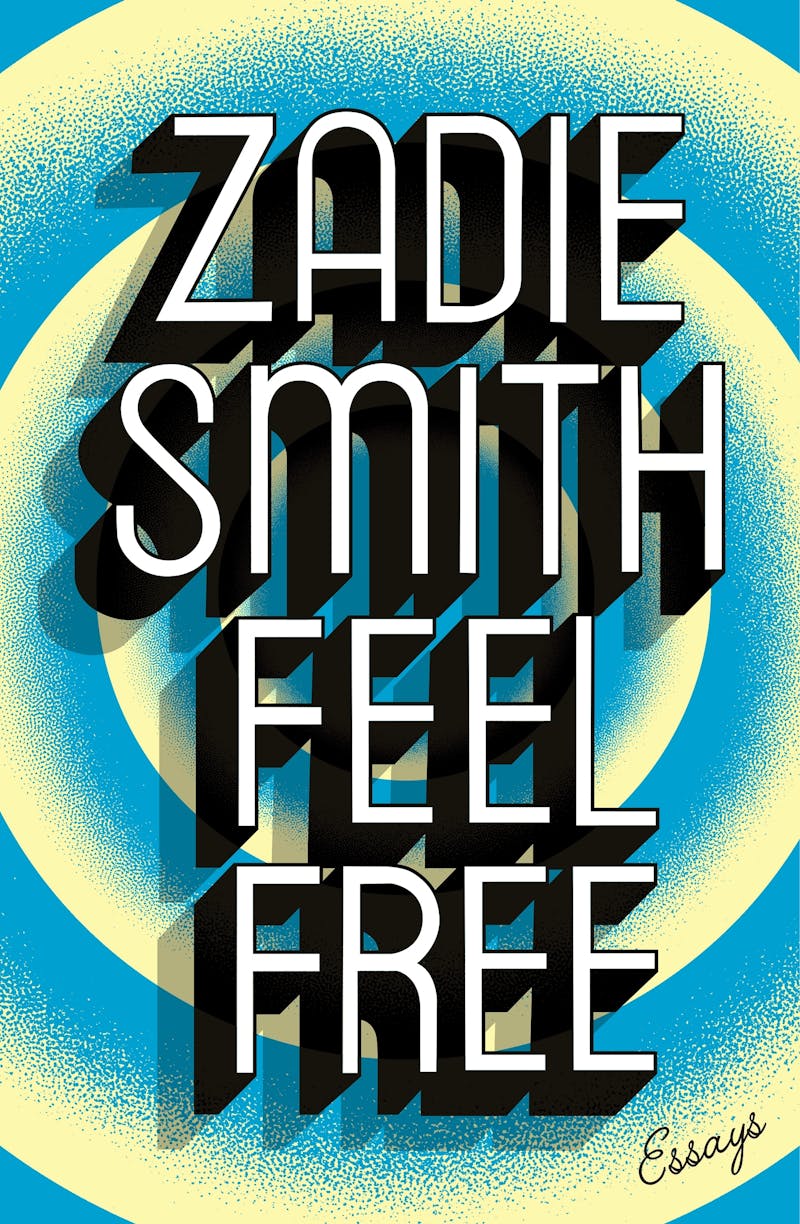“If I have any gift at all,” Zadie Smith admits in one of the essays in Feel Free, “it’s for dialogue—that trick of breathing what-looks-like-life into a collection of written sentences.” Smith does voices. Sometimes literally: an audio recording of her reading her story “Escape from New York,” includes the treat that is impressions of its three characters, Michael Jackson, Marlon Brando, and Elizabeth Taylor. Her fiction, of course, is full of voices, but the rendering of this familiar trio and their escape occupies that fertile gray area somewhere between entirely real and entirely fabricated. It isn’t mimicry, which leads nowhere, but a curious sort of imaginary impersonation, which leads everywhere.

Imaginary impersonation sounds like a purely fictional mode, yet it’s the way she approaches all writing, which brings together “three precarious, uncertain elements: language, the world, the self.” It is these three, she tells us in her introduction, that constitute writing “(for me)”. The parentheses are important because it’s the final category that’s the real kicker. Selfhood—other people’s—is what she returns to again and again, through what else but her own shifting and brilliant subjectivity. So it is that instead of a straight “introductory essay for a book of Billie Holiday photos,” Smith writes a bravura monologue, a virtuosic act of ventriloquism. Tellingly, it’s in the second person: Zadie-as-Billie-as-“you”.
In fact—though many aren’t hip to this yet—not only is there no more Eleanora, there isn’t any Billie either. There is only Lady Day. Alligator bag, three rows of diamonds nice and thick on your wrist—never mind that it’s three o’ clock in the afternoon. You boil an egg in twinset and pearls.
“I did try to write an essay about Billie,” Smith admits in a glum little shrug of a footnote, “but every angle seemed too formal or cold.” When your subject presents herself to you with the intimacy of a first name, and when that “you” identifies as a “sentimental humanist” it would only be a travesty to respond with the detachment of cool appraisal.
Smith’s great fascination with selfhood rests in its contingency. In an essay on the artist Lynette Yiadom-Boakye, who paints anonymous, elegant black figures, Smith quotes the painter Chris Ofili. Responding to the intimacy of the paintings, Ofili had marveled at, “the tightness of her bun. The size of his ear. She knew so much about so little about him. She said so little he heard so much.” “Exactly,” Smith enthuses, taking up where Ofili left off. “Here are some paintings of he and she, him and her. They say little, explicitly, but you hear so much.” Ofili, in these elliptical sentences, leaps from small, specific and personal details, to some felt, relational truth, and this is very much Smith’s mode as both fiction writer and critic.
Noting the New Museum show’s red walls, a color that strikes her as being redolent of “the calico covers of nineteenth-century novels,” Smith proposes that the color “has the effect of bringing a diverse selection of souls together, framing and containing them, much like a novel contains its people, which is to say, only partially.” It’s this partial containment, the generosity it grants, that appears to yield this next impression. The paintings “seem to have souls—that ultimate retrogressive term!—though by “soul” we need to imply nothing more metaphysical here than the sum total of one person’s affect in the mind of another.”
This definition of soul, “one person’s affect in the mind of another” resonates throughout the collection, and finds full expression when Smith considers Justin Bieber in relation to the Jewish philosopher Martin Buber. “Meet Justin Bieber!” is a very funny essay but it it also, and this is the quiet miracle of it, wholly intellectually sound. Bieber, as Smith puts it with benign provocation, “is still not yet a person,” since (quoting Buber) “Individuality makes its appearance by being differentiated from other individualities.” Bieber, the globally famous love object, “meets only those who feel they have already met him, and already love him.” Unlike, say, an encounter between Bieber and one of his fans at a corporate meet-and-greet in a stadium, this imaginary meeting between Bieber and Buber in Smith’s essay means something. It aspires, in fact, toward Buber’s own definition of meeting, which Smith renders as, “an intimate, complex, and precious state, a state we achieve only rarely.”
Elsewhere, in an essay that discusses both Charlie Kaufman’s genius stop-motion film Anomalisa and Schopenhauer, Smith writes: “I waited in the dark for something not quite human—and all too human—to begin.” There is an artistic generosity to the category of “not quite human and all too human.” This is the territory of fiction: The three dead celebrities reanimated as versions of themselves in “Escape from New York” are not quite human and all too human. So is the persuasive reality of an anonymous, made-up woman’s bun in a painting. Likewise, the puppets in Anomalisa, with their arrestingly lifelike eyes yet visible seams are “mixture of artifice and realism”.
This, too, speaks to the notion of “The I Who Is Not Me”, the title of an essay on writing in the first person. 2016’s Swing Time marked a departure from the third person. There is a certain comfort in writing at one remove from characters, but there is also an implicit political imperative. Considering her third novel, 2005’s On Beauty, Smith writes: “This is the kind of fiction I have always loved to write and read: worming itself into many different bodies, many different lives. Fiction that faces outwards, toward others.” Fiction, in other words, that is generative, freeing, to both writer and reader. But writing in the first person offers an alternative version of freedom: “It creates a space that allows for the writer’s experience and the reader’s simultaneously, a world in which Portnoy is at once entirely Philip Roth and not Philip Roth at all. That sounds like an impossible identity, but literature, for me, is precisely the ambivalent space in which impossible identities are made possible, both for their authors and their characters.”
It’s in impossible identities that we find freedom. And then comes a litany of names, first names whose surnames are implicit (as with “Billie” earlier), names that each conjure up many voices, their own voice and their characters’s voices and their literary antecedents,’ and then the overarching voice, the “voice” of their individuality: “I am Philip, I am Colson, I am Jonathan,” Smith announces, “I am Rivka, I am Virginia, I am Sylvia, I am Zora, I am Chinua, I am Saul, I am Toni, I am Nathan, I am Vladimir, I am Leo, I am Albert, I am Chimamanda.”
She contains multitudes, but her point is we all do. At the same time, we are, in our endless difference, nobody but ourselves. The philosophical experiment of “doing” all these other voices, comes from her own recognition of herself as a biracial British child of the 70s: “Not to take yourself as a natural, unquestionable entity,” she writes, “can lead you in turn to become aware of the radical contingency of life in general, its supremely accidental nature.” Who we are is, to a great degree, chance. We so easily could have been someone else. As one character says in White Teeth, “Our children will be born of our actions. Our accidents will become their destinies.”
In her celebrated essay “Joy”, Smith writes that one source of daily pleasure for her is “other people’s faces”—their specificity, the irreducibly human individuality therein, nobody’s but their own. The subtlest joy of these essays is sensing Smith’s own personhood, a personhood inseparable from her intellectual life. The self encompasses both. After the bracing dynamics of so much thought, the essays in Feel Free leave the reader not with a succinct theory of metaphysical dialogue between a global pop phenomenon and twentieth-century philosopher, but rather an image: the endearing, enduring image of one of our finest public intellectuals bickering with her husband, in a car, as she hankers for a sausage roll.
